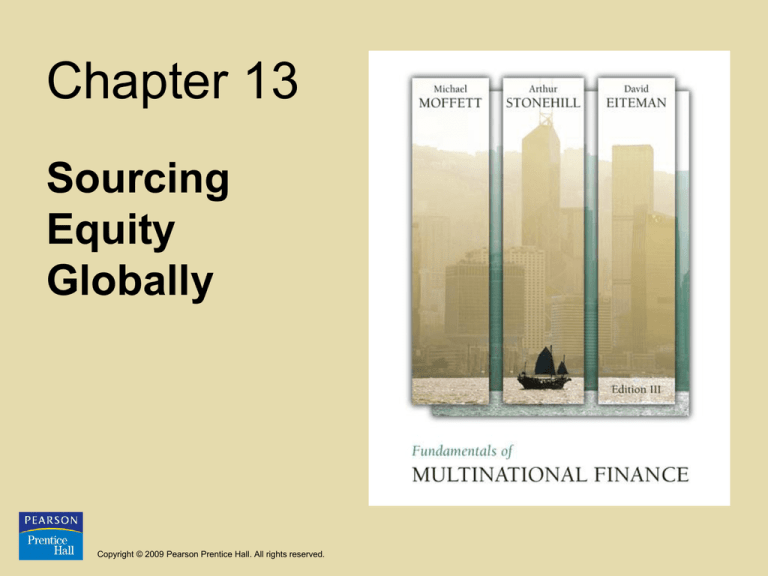
Chapter 13
Sourcing
Equity
Globally
Copyright © 2009 Pearson Prentice Hall. All rights reserved.
Sourcing Equity Globally: Learning
Objectives
• Design a strategy to source equity globally
• Analyze the motivations and goals of a firm issuing
new equity shares on foreign equity markets
• Analyze the motivations and goals of a firm issuing
new equity shares on foreign equity markets
• Understand the many barriers to penetrate effectively
foreign equity markets through cross-listing and selling
equity abroad
• Examine the various financial instruments which can be
used to source equity in the global equity markets
Copyright © 2009 Pearson Prentice Hall. All rights reserved.
13-2
Designing a Strategy to
Source Equity Globally
• This requires management to agree upon a long-run
financial objective and then choose among various
alternative paths to get there
• Normally the choice of paths and implementation is aided
by an early appointment of an investment bank as official
advisor to the firm
• Investment bankers are in touch with the potential foreign
investors and what they require in terms of risk/reward
• Investment bankers can also help navigate the various
institutional requirements and barriers that must be satisfies
to source equity globally
Copyright © 2009 Pearson Prentice Hall. All rights reserved.
13-3
Designing a Strategy to
Source Equity Globally
• Most firms raise their initial capital in their own domestic
market
• While many can be tempted to skip the intermediate steps to
complete an Euroequity issue in global markets, good
financial advisors will offer a ‘reality check’ on this strategy
• Most firms that have only raised capital in their domestic
market are not well enough known to attract foreign
investors
• The following exhibit walks through a more probable chain
of events in accessing global capital markets with the end
goal being equity capital
Copyright © 2009 Pearson Prentice Hall. All rights reserved.
13-4
Exhibit 13.1 Alternative Paths to Globalize
the Cost and Availability of Capital
Copyright © 2009 Pearson Prentice Hall. All rights reserved.
13-5
Sourcing Equity Globally
• Depositary Receipts
– Depositary receipts are negotiable certificates issued by a
bank to represent the underlying shares of stock, which are
held in trust at a foreign custodian bank
• Global Depositary Receipts (GDRs) – refers to certificates traded
outside the US
• American Depositary Receipts (ADRs) – are certificates traded in the
US and denominated in US dollars
• ADRs are sold, registered, and transferred in the US in the same
manner as any share of stock with each ADR representing some
multiple of the underlying foreign share
Copyright © 2009 Pearson Prentice Hall. All rights reserved.
13-6
Sourcing Equity Globally
• Depositary Receipts
– This multiple allows the ADRs to possess a price per
share conventional for the US market
– ADRs are either sponsored or unsponsored
– Sponsored ADRs are created at the request of a
foreign firm wanting its shares traded in the US; the
firm applies to the SEC and a US bank for
registration and issuance
Copyright © 2009 Pearson Prentice Hall. All rights reserved.
13-7
Exhibit 13.2 Mechanics of American
Depositary Receipts (ADRs)
Copyright © 2009 Pearson Prentice Hall. All rights reserved.
13-8
Exhibit 13.3
Characteristics of Depositary Receipt
Programs Traded in the United States
Copyright © 2009 Pearson Prentice Hall. All rights reserved.
13-9
Foreign Equity Listing & Issuance
• By cross-listing and selling its shares on a foreign
stock exchange a firm typically tries to accomplish
one or more of the following objectives:
– Improve the liquidity of its existing shares and support a liquid
secondary market
– Increase its share price by overcoming mispricing in a segmented
and illiquid home market
– Increase the firm’s visibility and political acceptance to its
customers, suppliers, creditors & host governments
– Establish a secondary market for shares used for acquisitions
– Create a secondary market for shares that can be used to
compensate local management and employees in foreign
subsidiaries
Copyright © 2009 Pearson Prentice Hall. All rights reserved.
13-10
Size and Liquidity of Markets
• Three key trends in the evolution of modern
exchanges:
– Demutualization or the end of market ownership by
a small, privileged group of “seat owners”
– Diversification by exchanges to trade a broader
range of products
– Globalization or effectively another form of
diversification through several techniques
Copyright © 2009 Pearson Prentice Hall. All rights reserved.
13-11
Foreign Equity Listing & Issuance
• Cross-listing is a way to encourage investors to
continue to hold and trade shares that may or may not
be listed on an investors home market or in a preferred
currency
• Cross-listing is usually done through ADRs (in the
United States, where they are traded and quoted in U.S.
dollars)
• Global Registered Shares (GRSs), on the other hand,
are able to be traded on equity exchanges around the
globe in a variety of currencies and are traded
electronically
Copyright © 2009 Pearson Prentice Hall. All rights reserved.
13-12
Effect of Cross-Listing
on Share Price
• The impact on price of cross-listing on a foreign
stock market depends on the degree to which the
markets are segmented
• As was the situation experienced by Novo, a
firm can benefit if a foreign market values a
company more highly than a home market (in a
highly-segmented situation)
Copyright © 2009 Pearson Prentice Hall. All rights reserved.
13-13
Other Motives for Cross-Listing
• Increasing visibility and political acceptance
– MNEs list in markets where they have substantial physical
operations
– Political objectives might include the need to meet local
ownership requirements for an MNE’s foreign joint venture
• Increasing potential for share swaps with acquisitions
• Compensating management and employees
Copyright © 2009 Pearson Prentice Hall. All rights reserved.
13-14
Barriers to Cross-Listing
and Selling Equity Abroad
• Commitment to disclosure and investor relations
– A decision to cross-list must be balanced against the
implied increased commitment to full disclosure and
a continuing investor relations program
• Disclosure is a double-edged sword
• Increased firm disclosure should have the effect of
lowering the cost of equity capital
• On the other hand, this increased disclosure is a costly
burden to corporations
Copyright © 2009 Pearson Prentice Hall. All rights reserved.
13-15
Alternative Instruments
to Source Equity
• Alternative instruments to source equity in global
markets include the following:
– Sale of a directed public share issue to investors in a target
market
– Sale of a Euro equity public issue to investors in more than
one market, including both foreign and domestic markets
– Private placements under SEC Rule 144A
– Sale of shares to private equity funds
– Sale of shares to a foreign firm as a part of a strategic
alliance
Copyright © 2009 Pearson Prentice Hall. All rights reserved.
13-16
Alternative Instruments
to Source Equity
• Directed Public Share Issues
– Defined as one which is targeted at investors in a
single country and underwritten in whole or in part
by investment institutions from that country
• Issue may or may not be denominated in the currency of
the target market
• The shares might or might not be cross-listed on a stock
exchange in the target market
• A foreign share issues, plus cross-listing can provide it
with improved liquidity
Copyright © 2009 Pearson Prentice Hall. All rights reserved.
13-17
Alternative Instruments
to Source Equity
• Euroequity Public Issue
– Gradual integration of worlds’ capital markets has spawned
the emergence of a Euroequity market
– A firm can now issue equity underwirtten and distributed in
multiple foreign equity markets; sometimes simultaneously
with distribution in the domestic market
– As we have reviewed, the term “Euro” does not imply that the
issuers or investors are located in Europe, nor does it mean
the shares are sold in the currency “euro”
Copyright © 2009 Pearson Prentice Hall. All rights reserved.
13-18
Alternative Instruments
to Source Equity
• Private Placement Under SEC Rule 144A
– A private placement is the sale of a security to a small set of
qualified institutional buyers
– Investors are traditionally insurance companies and
investment companies
– Because shares are not registered for sale, investors typically
follow “buy and hold” strategy
– Rule 144A allows qualified institutional buyers (QIB) to trade
privately placed securities without previous holding period
restrictions and without requiring SEC registration
Copyright © 2009 Pearson Prentice Hall. All rights reserved.
13-19
Alternative Instruments
to Source Equity
• Private Equity Funds
– Limited partnerships of institutional and wealthy individual
investors that raise their capital in the most liquid capital
markets
– Then invest these funds in mature, family-owned firms
located in emerging markets
• Strategic Alliances
– Normally followed by firms that expect to gain synergies
from one or more joint efforts
Copyright © 2009 Pearson Prentice Hall. All rights reserved.
13-20
Summary of Learning Objectives
• Designing a capital sourcing strategy requires
management to agree upon a long run financial
objective
• The firm must then choose among the various
alternative paths to get there, including where to
cross-list its shares and where to issue new
equity and in what form
Copyright © 2009 Pearson Prentice Hall. All rights reserved.
13-21
Summary of Learning Objectives
• A firm cross-lists its shares on foreign stock
exchanges for one or more of the following reasons
– Improving liquidity of its existing shares through depositary
receipts
– Increase its share price by overcoming mispricing by a segmented,
illiquid home market
– Support a new equity issue sold in a foreign market
– Establish a secondary market for shares used in acquisitions
– Increase the firm’s visibility & political acceptance to its
customers, suppliers, creditors and host governments
– Create a secondary market for shares that will be used to
compensate local management and employees in foreign subsidiary
Copyright © 2009 Pearson Prentice Hall. All rights reserved.
13-22
Summary of Learning Objectives
• If it is to support a new equity issue or to establish a
market for share swaps, the target market should also
be the listing market
• If it is to increase the firm’s commercial and political
visibility or to compensate local management and
employees, it should be in markets in which the firm
has significant operations
• The major liquid stock markets are the NYSE,
NASDAQ, LSE, Euronext, Tokyo, and Deutsche
Bourse
Copyright © 2009 Pearson Prentice Hall. All rights reserved.
13-23
Summary of Learning Objectives
• By cross-listing and selling equity abroad, a firm faces
two barriers
– Increased commitment to full disclosure
– A continuing investor relations program
• Non-U.S. firms must think twice before cross-listing in
the United States. Not only are the disclosure
requirements onerous, but continuous timely quarterly
information is required by U.S. regulators and
investors. This is very costly.
Copyright © 2009 Pearson Prentice Hall. All rights reserved.
13-24
Summary of Learning Objectives
• A firm can lower its cost of capital and increase its
liquidity by selling its shares to foreign investors in a
variety of forms
– Sale of a directed share issue to investors in one particular
foreign equity market
– Sale of a Euroequity share issue to foreign investors
simultaneously in more than one market, including both
foreign and domestic markets
– Private placement under SEC rule 144A
– Sale of shares to private equity funds
– Sales of shares to a foreign firm as part of a strategic alliance
Copyright © 2009 Pearson Prentice Hall. All rights reserved.
13-25







